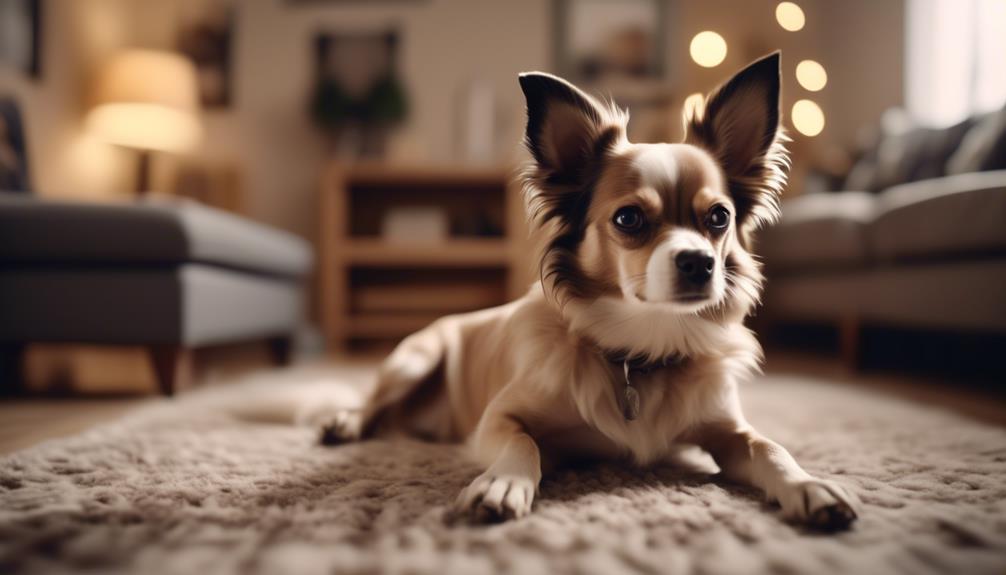How to Determine the Right Size Dog for Your Living Space

Finding the right size dog for your living space involves considering factors such as breed, energy levels, and age. This is important to ensure a happy and comfortable coexistence.
Key Takeaways
- Consider the weight, height, and measurements of your dog when choosing a dog house and ensure it is big enough for your dog to enter, turn around, and lie down comfortably.
- Larger dogs require more space, while smaller dogs are well-suited for smaller living spaces. Research different breeds and their typical sizes to determine compatibility with your living space.
- Take into account the energy level of the dog breed and assess your own activity level and ability to provide exercise. High-energy breeds require more space and regular exercise.
- Consider the age of the dog, as puppies require patience and training, while full-grown dogs may already be trained. Evaluate your availability for dog care and ability to provide mental stimulation and enrichment.
Assessing Your Living Space
Assess your living space to determine the appropriate size of dog house for your furry friend. Choosing the right size dog house is crucial for your dog's comfort and well-being. It's important to consider the weight, height, and measurements of your dog when making this decision. You want to ensure that the dog house is just big enough for your dog to enter, turn around, and lie down comfortably. A dog house that's too small can make your dog feel cramped and uncomfortable, while a dog house that's too large may not provide enough warmth and security.
Additionally, take into account the geographical location and climatic conditions of your area. If you live in a colder climate, it may be beneficial to choose a larger dog house with insulation or a heating system. On the other hand, if you live in a warmer climate, a smaller, well-ventilated dog house may be more suitable.
Using the A-B-C method can help you determine the correct size dog house. Consider the door height, width, length, and overall height to find the perfect fit for your furry friend. Lastly, remember to raise or block up the dog house off the ground. This won't only provide better temperature control but also deter flea infestation.
Understanding Breed Sizes

After assessing your living space and understanding the appropriate size for your dog house, it's important to consider breed sizes when choosing the right fit for your furry friend.
Different breeds come in various sizes, and it's crucial to choose a dog that's compatible with your living environment. Here are some factors to consider when understanding breed sizes:
- Larger dogs: Breeds such as Great Danes, Mastiffs, and Bernese Mountain Dogs are known for their larger size. These dogs require more space to move around comfortably and may need a larger dog house.
- Small dogs: Breeds like Chihuahuas, Pomeranians, and French Bulldogs are considered small dogs. They're well-suited for smaller living spaces and can thrive in apartments or houses with limited square footage.
- Size of the dog park: If you plan on taking your dog to a dog park frequently, it's important to choose a breed that's compatible with the park's size. Larger breeds may require more space to run and play.
- Consider a dog trainer: If you're unsure about the appropriate breed size for your living space, consulting with a professional dog trainer can be beneficial. They can provide guidance and help you choose the right fit for your home.
- Research breeds: Take the time to research different breeds and their typical sizes. This will give you an idea of which breeds are suitable for your living space.
Considering Energy Levels

Considering the energy levels of different dog breeds is essential when choosing the right fit for your living space. Assessing the energy level of the breed and matching it to your living space's size and exercise capabilities will help you make an informed decision.
High-energy breeds require more space and regular exercise to thrive, while low-energy breeds may be content with smaller living spaces. It's important to remember that a lively dog in a small space may develop behavioral issues due to pent-up energy. Therefore, it's crucial to consider the dog's energy level in relation to your living space.
Larger living spaces are generally more suitable for higher energy dogs, as they provide ample room for them to run and play. On the other hand, smaller living spaces can be appropriate for lower energy dogs, as long as they receive sufficient mental and physical stimulation.
When determining the right size dog for your living space, taking into account the energy levels of different breeds is crucial to ensure a harmonious living environment for both you and your furry companion.
Factoring in Age

When factoring in the age of the dog, it's important to consider their training level and your own preferences and capabilities. Age plays a significant role in a dog's behavior and training needs. Here are some key points to keep in mind:
- Puppies require patience and training: If you choose a puppy, be prepared to invest time and effort into their training. Puppies need guidance to learn basic commands and proper behavior.
- Full-grown dogs may already be trained: Opting for a full-grown dog means that they might already have some level of training. This can be advantageous if you prefer a dog that knows basic commands and has good behavior.
- Rescues often assess training levels: When adopting from a rescue, they usually conduct behavioral testing to determine the dog's training level. This can help you make an informed decision based on your specific needs.
- Dogs that know basic commands can learn more: If you prefer a dog that can learn more advanced commands, consider adopting one that already knows the basics. This will give you a head start in training them further.
- Consider the age of the dog for your living space: When determining the right size dog for your living space, take into account the dog's body size, including their height at the shoulder, head, and door height. This will ensure they've enough space and can comfortably fit in your home or big size dog house.
Determining Breed-Specific Space Needs

Determining the appropriate amount of space for a dog based on its breed is essential for ensuring its comfort and well-being. Different dog breeds have different space needs, so it's important to consider these requirements when choosing a dog house or determining the living space for your furry friend.
For big size dog breeds, it's crucial to provide a dog house that's big enough for them to have enough room to move around comfortably. The dog house should be spacious enough for the dog to enter, turn around, and lie down without feeling cramped. Consider the weight and measurements of the dog when determining the size of the dog house, ensuring that it can support their weight and provide ample space.
Additionally, take into account the exercise needs of the dog breed. Some breeds require more physical activity and space to run around than others. If you have a high-energy breed, it's important to provide them with enough room to burn off their energy and meet their exercise needs.
Lastly, don't forget to consider the geographical location and climate when deciding on the size of the dog house. In colder climates, you may need a dog house that's insulated and provides additional space for bedding. In hotter climates, proper ventilation and shade are essential to keep your dog comfortable.
Balancing Indoor and Outdoor Space

To ensure that your dog has enough space to thrive, it's important to find a balance between indoor and outdoor areas that suits their size and energy level. Consider the following factors when balancing indoor and outdoor space for your dog:
- Size of your living space: Small living spaces like apartments may be suitable for small dog breeds, while larger breeds may need more outdoor space. Assess the size of your home and choose a dog that can comfortably fit in your indoor and outdoor areas.
- Energy level of the dog: Some breeds are generally more active and require more exercise. Match the energy level of the dog with the available indoor and outdoor space for exercise and activities.
- Enough space for movement: Ensure that both the indoor and outdoor environment provides enough space for the dog to move comfortably. This includes having enough room for them to play, run, and engage in regular physical activity.
- Compatibility with your living space: The dog's size should be compatible with the size and layout of your living space, both indoors and outdoors. Consider the size of the dog house and any specific requirements they may have.
- Choosing the right dog: When balancing indoor and outdoor space, it's important to choose a dog that fits well with your lifestyle and living situation. Consider your own energy levels, available time for exercise, and the specific needs of different breeds.
Other Considerations for Choosing the Right Size Dog

Consider the unique needs and temperament of your household when selecting the right size dog. When making the decision to adopt a dog, it's important to take into account various factors that will contribute to a harmonious living environment.
One important consideration is the amount of time you're willing and able to spend with your dog. Dogs need daily exercise and mental stimulation, so if you have a busy schedule or limited space, a smaller breed may be more suitable. On the other hand, if you have a large yard and enjoy spending time outdoors, a larger breed that requires more exercise may be a better fit.
It's also important to consider the mobility of your dog. If you live in a small apartment or have limited outdoor space, a larger breed may have difficulty moving around comfortably. Additionally, some larger breeds may have higher energy levels and require more space to play and exercise.
Frequently Asked Questions
How Do I Know What Size Dog to Get?
Knowing what size dog to get can be determined by considering factors such as ideal dog breeds for small living spaces, lifestyle assessment, exercise needs, home adaptations, and finding a dog that fits your personality and living space.
How Do I Estimate My Dog's Size?
How can you estimate your dog's size? Factors like genetics, nutrition, and exercise can affect a dog's growth. To get an idea, measure their height and consider their breed. Remember to choose a dog size that fits your lifestyle and living space.
How Big Should My Apartment Be for a Dog?
When considering how big an apartment should be for a dog, factors such as space requirements, apartment layout, activity level, breed considerations, indoor vs outdoor living, noise tolerance, and lifestyle compatibility should all be taken into account.
How Do I Choose the Right Size Dog House?
When choosing the right size dog house, consider factors like the dog's weight and measurements, weather conditions, and proper ventilation. Use the A-B-C Method to determine the correct size and don't forget about maintenance and weatherproofing.









